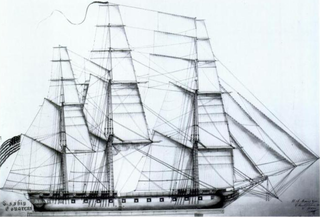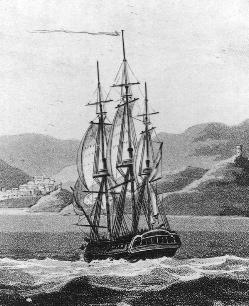
USS Constitution, also known as Old Ironsides, is a wooden-hulled, three-masted heavy frigate of the United States Navy. She is the world's oldest commissioned naval vessel still afloat. She was launched in 1797, one of six original frigates authorized for construction by the Naval Act of 1794 and the third constructed. The name "Constitution" was among ten names submitted to President George Washington by Secretary of War Timothy Pickering in March of 1795 for the frigates that were to be constructed. Joshua Humphreys designed the frigates to be the young Navy's capital ships, and so Constitution and her sister ships were larger and more heavily armed and built than standard frigates of the period. She was built at Edmund Hartt's shipyard in the North End of Boston, Massachusetts. Her first duties were to provide protection for American merchant shipping during the Quasi-War with France and to defeat the Barbary pirates in the First Barbary War.

William Bainbridge was a Commodore in the United States Navy. During his long career in the young American Navy he served under six presidents beginning with John Adams and is notable for his many victories at sea. He commanded several famous naval ships, including USS Constitution, and saw service in the Barbary Wars and the War of 1812. Bainbridge was also in command of USS Philadelphia when she grounded off the shores of Tripoli in North Africa, resulting in his capture and imprisonment for many months. In the latter part of his career he became the U.S. Naval Commissioner.

USS Mississippi (BB-41/AG-128), the second of three members of the New Mexico class of battleship, was the third ship of the United States Navy named in honor of the 20th state. The ship was built at the Newport News Shipbuilding Company of Newport News, Virginia, from her keel laying in April 1915, her launching in January 1917, and her commissioning in December that year. She was armed with a battery of twelve 14-inch (356 mm) guns in four three-gun turrets, and was protected by heavy armor plate, with her main belt armor being 13.5 inches (343 mm) thick.

USS Congress was a nominally rated 38-gun wooden-hulled, three-masted heavy frigate of the United States Navy. James Hackett built her in Portsmouth New Hampshire and she was launched on 15 August 1799. She was one of the original six frigates whose construction the Naval Act of 1794 had authorized. The name "Congress" was among ten names submitted to President George Washington by Secretary of War Timothy Pickering in March of 1795 for the frigates that were to be constructed.Joshua Humphreys designed these frigates to be the young Navy's capital ships, and so Congress and her sisters were larger and more heavily armed and built than the standard frigates of the period.

USS Philadelphia, a 1240-ton, 36-gun sailing frigate, was the second vessel of the United States Navy to be named for the city of Philadelphia. Originally named City of Philadelphia, she was built in 1798–1799 for the United States government by the citizens of that city. Funding for her construction was the result of a funding drive which raised $100,000 in one week, in June 1798. She was designed by Josiah Fox and built by Samuel Humphreys, Nathaniel Hutton and John Delavue. Her carved work was done by William Rush of Philadelphia. She was laid down about November 14, 1798, launched on November 28, 1799, and commissioned on April 5, 1800, with Captain Stephen Decatur, Sr. in command. She is perhaps best remembered for her burning after being captured in Tripoli.

USS Constellation was a nominally rated 38-gun wooden-hulled, three-masted frigate of the United States Navy.

The second USS Norfolk (DL-1) was the first destroyer leader of the United States Navy. Originally projected as a hunter-killer cruiser, she was in service until 1970.

USS Congress (1841)—the fourth United States Navy ship to carry that name—was a sailing frigate, like her predecessor, USS Congress (1799).

USS Jacob Jones was a Tucker-class destroyer built for the United States Navy prior to the American entry into World War I. The ship was the first U.S. Navy vessel named in honor of Jacob Jones.

HMS Java was a British Royal Navy 38-gun fifth-rate frigate. She was originally laid down in 1805 as Renommée, described as a 40-gun Pallas-class French Navy frigate, but the vessel actually carried 46 guns. The British captured her in 1811 in a noteworthy action during the Battle of Tamatave, but she is most famous for her defeat on 29 December 1812 in a three-hour single-ship action against USS Constitution. Java had a complement of about 277, but during her engagement with Constitution she allegedly had 426 aboard, in comparison with her opponent's 475.

The third USS Hornet was a brig-rigged sloop-of-war in the United States Navy. During the War of 1812, she was the first U.S. Navy ship to capture a British privateer.
The first USS George Washington was a frigate in the United States Navy. She was named after President George Washington.

USS Lynx, a 6-gun Baltimore Clipper-rigged schooner, was built for the United States Navy by James Owner of Georgetown, Washington, D.C., in 1814, intended for service in one of the two raiding squadrons being built as part of President James Madison's administration’s plan to establish a more effective Navy, one capable not only of breaking the British naval blockade, but also of raising havoc with the British merchant marine.

The first USS Macdonough (DD-9) was a Lawrence-class destroyer, which was a sub-class of Bainbridge-class destroyer, in the United States Navy. She was named for Commodore Thomas Macdonough

The Mediterranean Squadron, also known as the Mediterranean Station, was part of the United States Navy in the 19th century that operated in the Mediterranean Sea. It was formed in response to the First and Second Barbary Wars. Between 1801 and 1818, the squadron was composed of a series of rotating squadrons. Later, squadrons were sent in the 1820s to the 1860s to suppress piracy, primarily in Greece and to engage in gunboat diplomacy. In 1865 the force was renamed the European Squadron.

USS Bainbridge (DDG-96) is an Arleigh Burke-class guided missile destroyer in the United States Navy. She is the fifth ship to carry that name, and the 46th destroyer of a planned 75-ship class. Bainbridge is named in honor of Commodore William Bainbridge, who as commander of the frigate USS Constitution distinguished himself in the War of 1812 when he and his crew captured HMS Java, a 38-gun fifth-rate frigate of the Royal Navy.

United States Naval Training Center Bainbridge was the U.S. Navy Training Center at Port Deposit, Maryland, on the bluffs of the northeast bank of the Susquehanna River. It was active from 1942 to 1976 under the Commander of the Fifth Naval District, based in Norfolk, Virginia.

USS Recruit was a landlocked "dummy" training ship of the United States Navy, located at the Naval Training Center in the Point Loma area of San Diego. She was built to scale, two-thirds the size of a Dealey-class destroyer escort, and was commissioned on July 27, 1949. Recruit was commissioned for 18 years, for much of that period the only landlocked ship to hold that status in the U.S. Navy.

Naval Training Center San Diego (1923–1997) is a former United States Navy base located at the north end of San Diego Bay. The Naval Training Center site is listed on the National Register of Historic Places, and many of the individual structures are designated as historic by the city of San Diego.

Stephen Decatur Jr. was a United States naval officer and commodore. He was born on the eastern shore of Maryland in Worcester County, the son of a U.S. naval officer who served during the American Revolution. His father, Stephen Decatur Sr., was a commodore in the United States Navy, and brought the younger Stephen into the world of ships and sailing early on. Shortly after attending college, Decatur followed in his father's footsteps and joined the U.S. Navy at the age of nineteen as a midshipman.




















